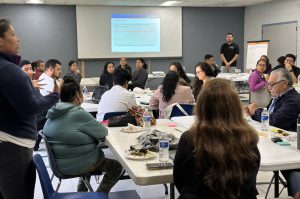
Celebrating 10 Years of SLATE-Z
Celebrating 10 Years of SLATE-Z A Legacy of Cultural Richness South Los Angeles has long been a place of cultural vibrancy, tracing its roots to
Variable Definitions:
Below 100% Poverty Threshold: The percentage of the population living in a family earning below 100% of the federal poverty threshold
Below 200% Poverty Threshold: The percentage of the population living in a family earning below 200% of the federal poverty threshold
Source:
American Community Survey (ACS), 5-year estimates, Table C17002
Years Available:
2010 – 2023
*Note: Each year of available data shown above is a 5-year estimate, or an average of data collected over a five year period. 5-year estimates are used to increase the reliability of the data at small geographies like neighborhoods and census tracts. The years shown on the NDSC map represent the final year of the five year average (e.g. “2010” represents 2006-2010 data, “2011” represents 2007-2011 data, and so on). For the most impactful comparison of data over time, the ACS recommends comparing non-overlapping years (e.g. 2010-14 with 2015-19).
Below Poverty Threshold
The federal poverty threshold is established annually by the U.S. Census Bureau to measure the number of people in poverty and is consistent across the country, despite how areas in the US have wildly different costs of living. Originally developed in 1963, FPL was designed to measure the cost of a subsistence diet – one that would prevent starvation and/or severe malnutrition – in addition to clothing, shelter, and utilities. In addition to the fact that individuals and families deserve to have resources that protect them from more than just severe malnutrition, FPL fails to address the changing needs and budgets of families, including expenses like child care and medical expenses. While FPL remains important for federal program funding and the availability of specific data, it is crucial to acknowledge that its philosophy and design are largely outdated. Therefore, whenever presenting FPL, it should always be presented with appropriate context and caveats to better understand its limitations.
As of 2023, the U.S. Department of Health and Human Services defines a four person family as low-income if they are making $30,000 or less a year. A separate “poverty guideline” is established each year by the Department of Health and Human Services (HHS) for administrative and federal program eligibility purposes. The HHS poverty measure provides a simplified guideline based on the number of individuals in a family, regardless of their age. These guidelines apply to the 48 contiguous states and the District of Columbia (the states of Alaska and Hawaii have higher guidelines due to elevated cost of living). In 2019, the federal poverty guideline for a family of four is $25,750.
While the two measures of poverty are very similar, the Census Bureau’s poverty threshold is the measure used for this variable. In addition to being a crucial diagnostic tool for the economic well-being of a community, measuring poverty is important because it determines eligibility for various public assistance programs and services. Often, programs use 138% or 200% of the federal poverty guideline as eligibility criteria.
In addition to the federal poverty line, there are other ways to further understand how to accurately quantify those living in poverty. The supplemental poverty measure was introduced in 2010 by the Census Bureau as an alternative way to define poverty in the U.S. The U.S. poverty rate is not the most accurate depiction of poverty and does little to capture the full extent of deprivation in the US and the full reach of government social programs. The SPM, in comparison to the federal poverty line, has different poverty thresholds and includes other sources of income. The SPM includes cash income from but also non-cash benefits like food stamps, subsidized school lunches, housing assistance, and more to offer a more well-rounded idea of income.
Furthermore, HUD (Department of Housing and Urban Development) uses area median income to make localized income limits. Most federal and State housing assistance programs set maximum incomes for eligibility to live in assisted housing, and maximum rents and housing costs that may be charged to eligible residents, usually based on their incomes.
Written by Rediet Retta
Citation:
“American Community Survey and Puerto Rico Community Survey 2015 Subject Definitions.” United States Census Bureau: American Community Survey, 2015. Link
Burwell, Sylvia M. “Department of Health and Human Services: Annual Update of the HHS Poverty Guidelines.” Federal Register, vol. 80, no. 14, 2015, pp. 3236. Link
U.S. Department of Health and Human Services. 2019 Federal Poverty Guidelines. Link
Donald J. Hernandez, and Jeffrey Napierala. “Mother’s Education and Children’s Outcomes: How Dual-Generation Programs Offer Increased Opportunities for America’s Children.” Foundation for Child Development, 9 July 2014, www.fcd-us.org/mothers-education-and-childrens-outcomes-how-dual-generation-programs-offer-increased-opportunities-for-americas-children/. Accessed 6 May 2023.
“Prior HHS Poverty Guidelines and Federal Register References.” ASPE, aspe.hhs.gov/topics/poverty-economic-mobility/poverty-guidelines/prior-hhs-poverty-guidelines-federal-register-references.

Celebrating 10 Years of SLATE-Z A Legacy of Cultural Richness South Los Angeles has long been a place of cultural vibrancy, tracing its roots to

Advancing a Collaborative Agenda in Southeast LA In 2022, the California Community Foundation (CCF) launched the Regional Recovery Hub to strengthen place-based coordination in Los Angeles County

In 2022, the California Community Foundation (CCF) launched the Regional Recovery Hub to strengthen place-based coordination in Los Angeles County regions that were most heavily impacted by
